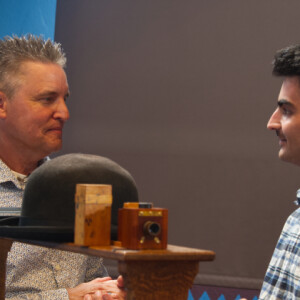Collodion wet-plate photography
I had never heard of Shane Balkowitsch until my eye was caught three weeks ago by a Pitt Rivers Museum promotion for a talk he was giving this afternoon about his old-technique photos of Native American people. I went.
In 2012 he was captivated by a blurry photo (of a motorbike!) on a social media site. He researched and found out that it was a wet-plate collodion photo - a photographic process invented in the mid 19th century and replaced about twenty years later by the daguerrotype. He was so entranced that, despite never having been interested in photography and not even owning a camera, he learnt how to create wet-plate images.
It's a slow process - requiring studio work or a portable dark room, as the plate has to be processed before it dries - so he can take no more than six photos a day. Think about that, digital photographers!
Early on, he came across a wet-plate collodion photo of Sitting Bull. That led to him contacting Sitting Bull's only living great-grandson, Ernie La Pointe, and offering to take his portrait. And that led to his (not yet completed) project to take 1,000 portraits of Native American people.
He has strong views about the role of photography in recording history (a bit rose-tinted, in my view) and has donated most of his work either to the subject of the portrait, or to museums and galleries around the world, including the Pitt Rivers in Oxford.
It was an interesting talk, followed by interesting answers to good questions. A couple of points I liked:
• In his will, his wife and children may choose three collodion plates each from his studio. The rest, with his studio, will go to the North Dakota State Historical Society. He talked about how family artefacts passed down through the generations lose meaning as the memory of the person who made them fades, until they become an encumbrance.
• He has taken photos of Greta Thunberg (whose possible display led to death threats) and of Jordan Peterson (which led to censure by the left - though not death threats). He didn't explicitly state which 'side' he is on, but did ask what legacy we are leaving if the only photos of people we dislike are taken by those who admire them.
Blip: three of his glass plates, donated to the Pitt Rivers Museum, along with high-quality numbered prints on the table of some of his work that we were invited to take
Extra: Shane Balkowitsch in conversation - with the smallest working collodion camera in the world (normally he takes 6"x8") and his trademark bowler hat.
Edit: this blip has provoked some very interesting exchanges and I now know a lot more than I did when I came out of the talk. See comments (with some time-consuming but fascinating links!) if you're interested.


Comments
Sign in or get an account to comment.


